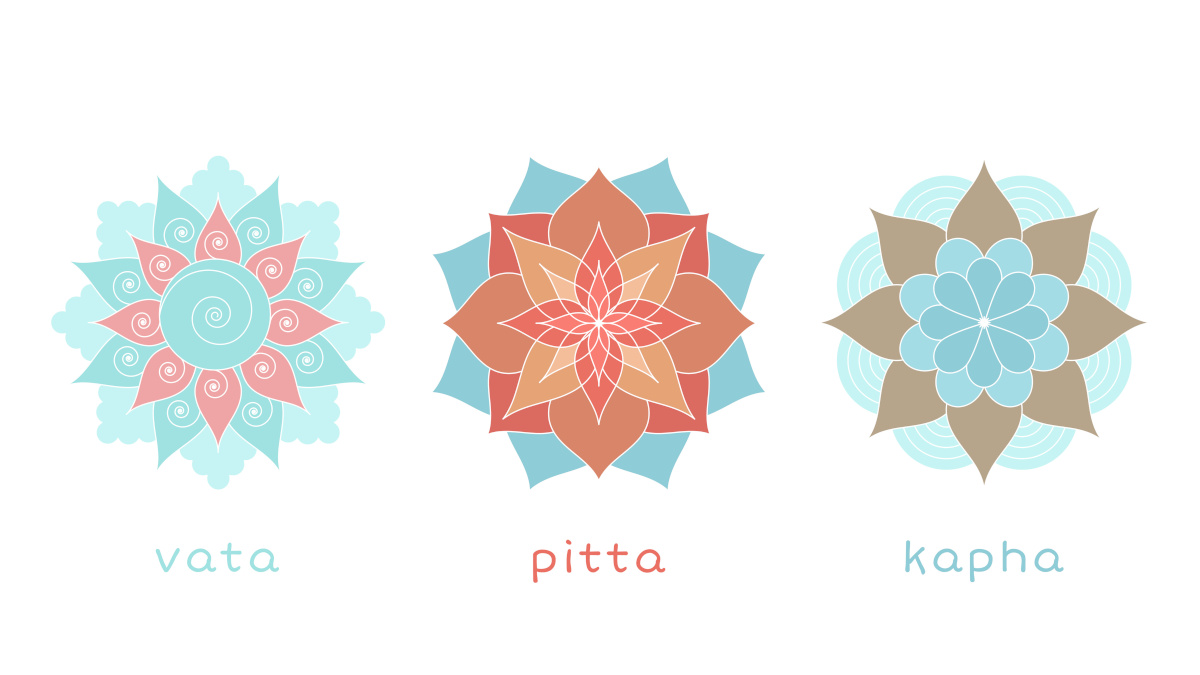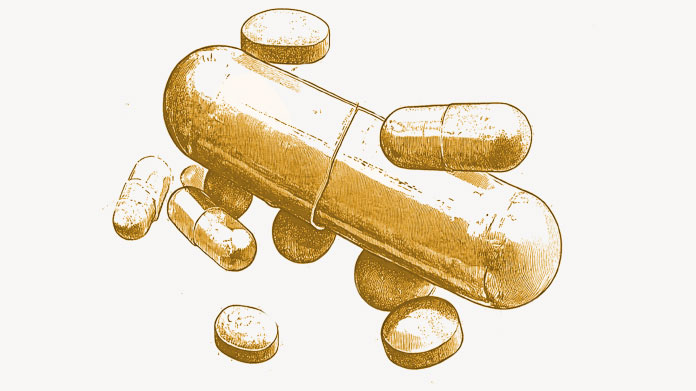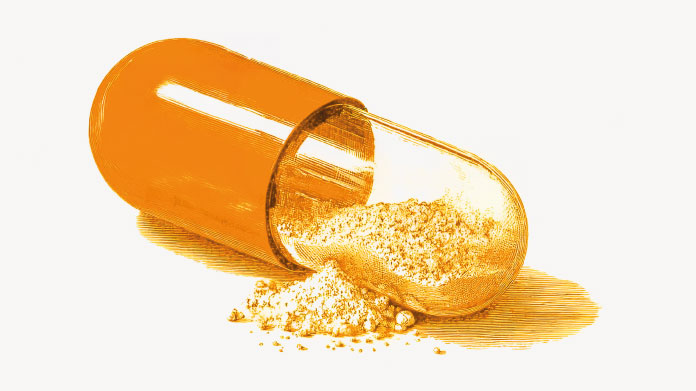Vata, pitta or kapha: which foods and supplements are best for you?
Are you more vata (wind), pitta (fire) or kapha (earth and water)? Discover which type of physiology and personality is the closest match for you, and which foods and supplements suit you best.

Doshas: how do they work?
According to Ayurveda, we are all made up of a mix of 3 distinct energy patterns called doshas:
- vata, composed of air and ether, governs the energy of movement;
- pitta, made of the elements water and fire, is all about the energy of transformation;
- kapha, composed of water and earth, is associated with cohesion.
Each of us is born with all three doshas, but in very different ratios: our own unique combination of these energies thus defines our Ayurvedic constitution which determines our physical and mental characteristics.
In general, one or two doshas predominate. In monodoshic constitutions (vata, pitta or kapha), there is a single dominant dosha. Most of us, however, fall into the bidoshic category (vata-pitta, vata-kapha ou pitta-kapha), while tridoshic constitutions, in which vata-pitta-kapha doshas are present in equal proportions, are very rare.
Why does it help to know our Ayurvedic constitution? Primarily so that we can identify our potential sources of imbalance and correct them by amongst others, adopting a suitable food regime. In practice, this means constantly tempering a dominant dosha with its opposite qualities. For example, a vata type, with an airy, dynamic nature, should prioritise warm, hearty foods which will help ‘stabilise’ them.
Vata: free as the wind
Physical and psychological characteristics of vata types
In Ayurvedic medicine, vata is characterised as light, dry, cold, rough, precise, subtle, mobile and clear. This manifests physically in a slight build, being fine-boneddry skin and feeling the cold. Vata types are not big eaters and prefer ‘grazing’. Their digestion is irregular with a tendency towards constipation.
Mentally, vatas are endlessly creative and hugely enthusiastic, but risk spreading themselves too thinly across numerous projects. Imbalance manifests in excessive nervousness.
Foods to be avoided by vatas
If you identify as a vata, try not to eat anything raw or cold (iced drinks, crudités ...). Limit your intake of dry or coarse foods (cabbage, potatoes, pulses ...) as well as stimulants.
Good food choices for vatas
Vatas should focus on sweet, salty and sour flavors, and opt for warm, creamy, satisfying foods to counteract their ‘lightness’. Their diet can therefore include plenty of fats (ghee, vegetable oils…) and moist or liquid foods (creamy soups, hot drinks …). All combined with warming and gas-relieving spices to support their digestion!
Supplements suitable for vatas
Digestion-wise, vatas can take lactic bacteria to support their gut flora(1), focusing on the bacterial strains most widely studied by scientists (as contained in Probio Forte, which combines Bifidobacterium, Lactobacillus and Lactococcus).
And what can they do to positively channel their over-active brains? Tulsi (also known as ‘holy basil’) has long featured in Ayurvedic medicine, as it helps to regulate stress and induce relaxation (2), while also maintaining vitality. In some synergistic supplements (such as Adrenal Support) it has been wisely combined with magnesium, which supports normal psychological function (3).
As vatas often suffer from insomnia, they should consider supplementing with melatonin. A hormone produced by the pineal gland in the brain, melatonin plays a key role in regulating the sleep/wake cycle and reducing the time it takes to fall asleep (4). It thus features in some formulations (such as Advanced Sleep Formula, where it’s combined with passiflora, the ultimate sedative herb).
Pitta: all fired up
Physical and psychological characteristics of pitta
The pitta dosha is described as hot, light, oily, mobile, pungent and sharp. Of average build, pitta types perspire a lot, their faces redden easily and they have huge appetites. Their main health issues are intrinsically linked to heat: heartburn, diarrhea, fever and inflammation.
Socially, pitta types present as natural leaders who like to persuade and convince. They have critical minds and an acute sense of logic. The other reverse side of this coin is that they are strong>quick to fly into a rage.
Foods pitta types should avoid
While pittas need to make sure they eat enough, they should avoid spicy and acidic flavors which fan the flames of their internal fire. So no chillies or cornichons/gherkins! Overly fatty or oily foods should only be consumed in moderation (meat, cheese …) and the same goes for stimulating drinks.
Good foods for pittas
If you’re a pitta type, bitter, sweet, and astringent tastes are ideal. Opt for crudités, grains, pulses, dairy products and sweet fruits (such as pears). Always cook them with a little fat.
Supplements suited to pitta types
Pittas are prone to fevers. Echinacea, used for centuries by Native Americans, helps the body’s defenses function properly as well as offering relief from a sore throat (5-6). Pitta types who experience problems like this can turn to appropriate supplementation (such as Immunity Booster based on organic echinacea).
Chronic inflammatory processes are often the result of an imbalance caused by a number of factors: genetic, dietary, stress, environmental ... Super-polyvalent supplements are available that help to restore inner harmony (such as InflaRelief, which combines 12 natural substances including bromelain and turmeric, as well as three high-quality, patented products) (7).
Kapha: a long, calm river
Physical and psychological characteristics of kapha
Heavy, dense, steady, cold, slow and soft are the qualities associated with kapha. Calm but forceful, the kapha type is by nature an over-eater. Typically sedentary, he or she gains weight easily, which can lead to significant metabolic problems such as diabetes. Kapha types stand out for their obvious slowness which is apparent in their digestion too.
Emotionally, kaphas are reserved. Loyal and kind, they make endearing and reliable friends who inspire confidence. Their great stability makes them somewhat averse to change.
Foods that should be avoided by kapha types
In short, they need to go easy on the salt, sugar and fat, and eat lightly! Kaphas should ideally steer clear of heavy grains (such as wheat), meat, dairy products and too much fat. Creamy dishes are also to be avoided.
Good food choices for kaphas
Warm, light, and dry food is favorable, or cooked light meals. Kaphas do best with lightly cooked foods or raw fruits and vegetables. Any food that is spicy is good for Kaphas such as very hot Mexican or Indian food, especially in winter. Dry cooking methods (baking, broiling, grilling, sautéing) are preferable for Kaphas over moist cooking such as steaming, boiling, or poaching. Foods such as romaine lettuce, endive, or tonic water are good for stimulating the Kapha appetite, while preferred spices are cumin, fenugreek, sesame seed, and turmeric.Kapha eating centers around a warm, dried and energised approach. Spices are therefore going to be their best friends! A vegetarian diet with plenty of cooked vegetables, fruits that aren’t too sweet, and pulses, will suit them perfectly. Gently steaming food, and drinking tea and coffee in moderation are also ideal for the kapha eating plan.
Supplements suitable for kapha types
When it comes to losing excess kapha weight, there’s no secret: you simply need to eat a balanced diet and take regular exercise. To support your efforts, you can also take advantage of supplementation (try, for example, the product TropiSlim, based on dragon fruit, or pitahaya, an exotic fruit with surprising benefits) (8-9).
Feeling listless? Ginseng is the perfect tonic. This key Chinese medicine plant helps to fight fatigue and maintain vitality. For optimal efficacy, make sure you choose a supplement with a high content of ginsenosides, the main active compounds in ginseng (try the excellent Ginseng 30%) (10).
Metabolising sugars properly is essential for kapha types. Banaba (Lagerstroemia speciosa L.) supports weight control and blood sugar control (11). It’s thus included in cutting-edge formulations (such as Glucofit, standardized to 18% corosolic acid).
Another option is moringa leaf (such as is found in the product Organic Moringa Leaf Extract). This Ayurvedic plant plays a role in breaking down glucose and helps to maintain normal blood sugar levels (12).
References
- Shi LH, Balakrishnan K, Thiagarajah K, Mohd Ismail NI, Yin OS. Beneficial Properties of Probiotics. Trop Life Sci Res. 2016;27(2):73-90. doi:10.21315/tlsr2016.27.2.6
- Jamshidi N, Cohen MM. The Clinical Efficacy and Safety of Tulsi in Humans: A Systematic Review of the Literature. Evid Based Complement Alternat Med. 2017;2017:9217567. doi:10.1155/2017/9217567
- Boyle NB, Lawton C, Dye L. The Effects of Magnesium Supplementation on Subjective Anxiety and Stress-A Systematic Review. Nutrients. 2017;9(5):429. Published 2017 Apr 26. doi:10.3390/nu9050429
- Xie Z, Chen F, Li WA, Geng X, Li C, Meng X, Feng Y, Liu W, Yu F. A review of sleep disorders and melatonin. Neurol Res. 2017 Jun;39(6):559-565. doi: 10.1080/01616412.2017.1315864. Epub 2017 May 1. PMID: 28460563.
- Zhai Z, Liu Y, Wu L, et al. Enhancement of innate and adaptive immune functions by multiple Echinacea species. J Med Food. 2007;10(3):423-434. doi:10.1089/jmf.2006.257
- Schapowal A, Berger D, Klein P, Suter A. Echinacea/sage or chlorhexidine/lidocaine for treating acute sore throats: a randomized double-blind trial. Eur J Med Res. 2009;14(9):406-412. doi:10.1186/2047-783x-14-9-406
- Jurenka JS. Anti-inflammatory properties of curcumin, a major constituent of Curcuma longa: a review of preclinical and clinical research. Altern Med Rev. 2009 Jun;14(2):141-53. Erratum in: Altern Med Rev. 2009 Sep;14(3):277. PMID: 19594223.
- Poolsup N, Suksomboon N, Paw NJ. Effect of dragon fruit on glycemic control in prediabetes and type 2 diabetes: A systematic review and meta-analysis. PLoS One. 2017;12(9):e0184577. Published 2017 Sep 8. doi:10.1371/journal.pone.0184577
- Oliynyk S, Oh S. Actoprotective effect of ginseng: improving mental and physical performance. J Ginseng Res. 2013;37(2):144-166. doi:10.5142/jgr.2013.37.144
- Klein G, Kim J, Himmeldirk K, Cao Y, Chen X. Antidiabetes and Anti-obesity Activity of Lagerstroemia speciosa. Evid Based Complement Alternat Med. 2007;4(4):401-407. doi:10.1093/ecam/nem013
- Nova E, Redondo-Useros N, Martínez-García RM, Gómez-Martínez S, Díaz-Prieto LE, Marcos A. Potential of Moringa oleifera to Improve Glucose Control for the Prevention of Diabetes and Related Metabolic Alterations: A Systematic Review of Animal and Human Studies. Nutrients. 2020;12(7):2050. Published 2020 Jul 10. doi:10.3390/nu12072050
Keywords
4 Days
Great customer service - responsive …
I ordered from them and my item was unavailable for sometime. I was super happy when they reactivated my order and shipped my item which arrived very quickly. Great customer service.
Ruth Rueter
5 Days
Super fast shipping
Super fast shipping
Donald Borling
8 Days
Reputable companysearch and the number of…
The research and the number of selection of products.
NAKHJAVAN Shervin
21 Days
The Anti Aromatase is a great product
The Anti Aromatase is a great product. You just need to have constant inventory. Recently this product has been out of stock.
GEORGE Verne
23 Days
Great help on chat
Great help on chat. Knowledgeable and friendly.
Jason Argos
26 Days
Customer service was fast and friendly.
Customer service helped to stop the transaction process of the subscription. I appreciated that.
Greenie
27 Days
I order here due to the high quality of…
I order here due to the high quality of the products and the quick delivery of items - thank you
Barbara J
28 Days
SuperSmart's Eye Pressure supplements: highly recommended!
I purchase SuperSmart's Eye Pressure supplements regularly for over 5 years, and gotta say they are truly a wonderful product for my Glaucoma. Highly recommended if you have eye pain from your Glaucoma.
D. Martinez
33 Days
Quick service
Quick service
MONELL
33 Days
Speedy service.
Speedy service.
ROSENTHAL Marvin
37 Days
Clear website- Efficient
Clear website. Excellent search engine and fast delivery!
Mohamad Hussein
39 Days
They have great products.
They have great products.
Vickie
40 Days
Great Shipping Time!
You Have A Great Shipping Time! Praise The Lord!
DMHoge
42 Days
Doctor Recommended!
Good pricing, very good availability, doctor recommended (couldn't find what I needed anywhere else), and it took only a week to arrive (which I can't complain about).
Al
42 Days
Great product and fast shipping
Great product and fast shipping
Marie





